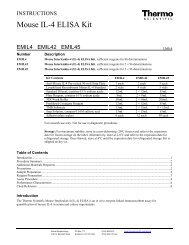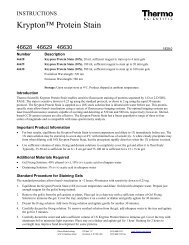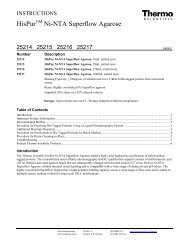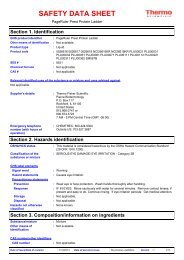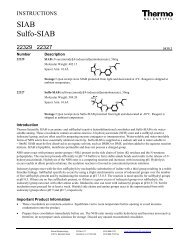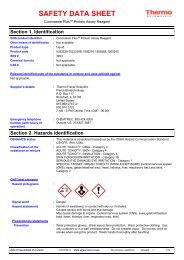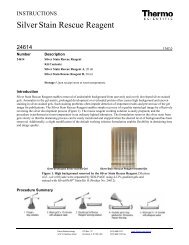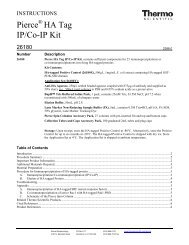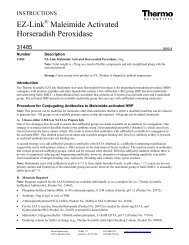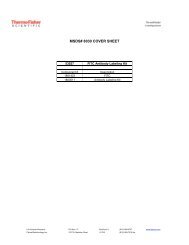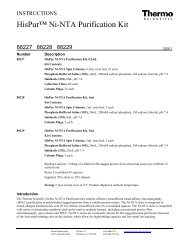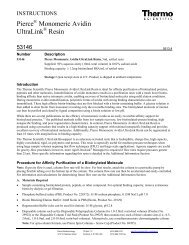Thermo Scientific Pierce Protein Assay Technical Handbook Version 2
Thermo Scientific Pierce Protein Assay Technical Handbook Version 2
Thermo Scientific Pierce Protein Assay Technical Handbook Version 2
Create successful ePaper yourself
Turn your PDF publications into a flip-book with our unique Google optimized e-Paper software.
BCA-based <strong>Protein</strong> <strong>Assay</strong>s<br />
Bicinchoninic Acid (BCA)-based <strong>Protein</strong> <strong>Assay</strong>s<br />
In 1985, Paul K. Smith, et al. introduced the BCA <strong>Protein</strong><br />
<strong>Assay</strong>. Since then it has become the most popular method<br />
for colorimetric detection and quantitation of total protein.<br />
The BCA <strong>Protein</strong> <strong>Assay</strong> has a unique advantage over the<br />
Modified Lowry <strong>Protein</strong> <strong>Assay</strong> and any of the Coomassie dyebased<br />
assays – it is compatible with samples that contain up<br />
to 5% surfactants (detergents).<br />
Briefly, the sample is added to the tube or plate containing the<br />
prepared BCA Working Reagent and after a 30-minute incubation<br />
at 37°C and cooling to room temperature, the resultant purple<br />
color is measured at 562nm. The protocol is similar for the Micro<br />
BCA <strong>Protein</strong> <strong>Assay</strong>, except the ratio of sample volume to working<br />
reagent is different and the tubes are incubated for 60 minutes<br />
at 60°C.<br />
Chemistry of BCA-based <strong>Protein</strong> <strong>Assay</strong>s<br />
The BCA <strong>Protein</strong> <strong>Assay</strong> combines the well-known reduction<br />
of Cu 2+ to Cu 1+ by protein in an alkaline medium with the highly<br />
sensitive and selective colorimetric detection of the cuprous<br />
cation (Cu 1+ ) by bicinchoninic acid (Figure 1). The first step is the<br />
chelation of copper with protein in an alkaline environment to<br />
form a blue colored complex. In this reaction, known as the biuret<br />
reaction, peptides containing three or more amino acid residues<br />
form a colored chelate complex with cupric ions in an alkaline<br />
environment containing sodium potassium tartrate. This became<br />
known as the biuret reaction because a similar complex forms<br />
with the organic compound biuret (NH 2 -CO-NH-CO-NH 2 ) and the<br />
cupric ion. Biuret, a product of excess urea and heat, reacts with<br />
copper to form a light blue tetradentate complex (Figure 2). Single<br />
amino acids and dipeptides do not give the biuret reaction, but tripeptides<br />
and larger polypeptides or proteins will react to produce<br />
the light blue to violet complex that absorbs light at 540nm. One<br />
cupric ion forms a colored coordination complex with four to six<br />
nearby peptides bonds.<br />
The intensity of the color produced is proportional to the number<br />
of peptide bonds participating in the reaction. Thus, the biuret<br />
reaction is the basis for a simple and rapid colorimetric reagent<br />
of the same name for quantitatively determining total protein concentration.<br />
Since the working range for the biuret assay is from<br />
5 to 160mg/mL, the biuret assay is used in clinical laboratories for<br />
the quantitation of total protein in serum.<br />
Step 1.<br />
Step 2.<br />
<strong>Protein</strong> + Cu 2+ 0H<br />
Cu 2+<br />
- 00C<br />
N N<br />
Cu 1 + + 2BCA Cu 1 +<br />
- 00C<br />
N BCA<br />
Cu 1 +<br />
N<br />
Complex<br />
COO -<br />
COO -<br />
Figure 1. Reaction schematic for the bicinchoninic acid (BCA)-containing<br />
protein assay.<br />
To order, call 800-874-3723 or 815-968-0747. Outside the United States, contact your local branch office or distributor.<br />
15



